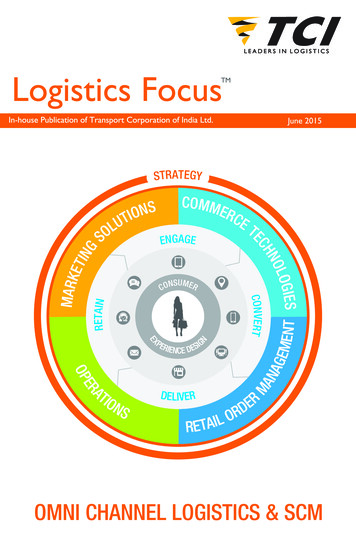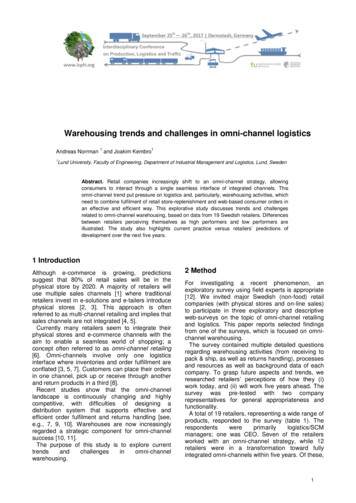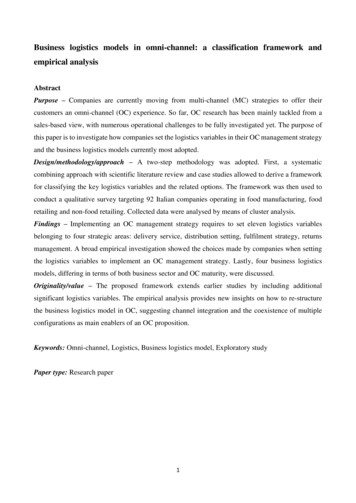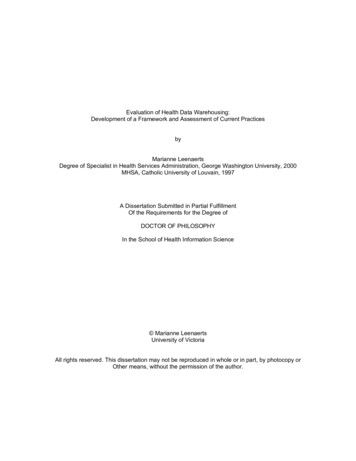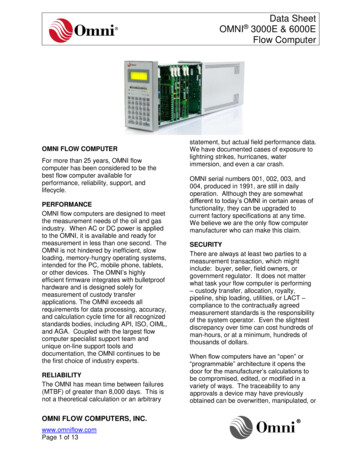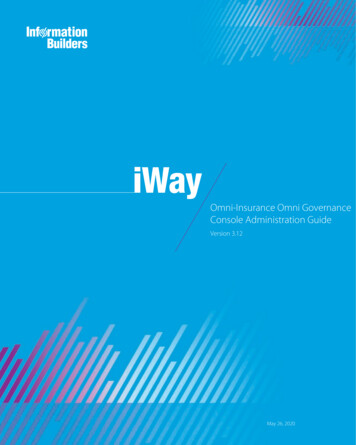
Transcription
Central Warehousing and Omni channellogistics strategyA case study of baby products provider and clothing retailerMASTER THESIS WITHIN: Business AdministrationNUMBER OF CREDITS: 30PROGRAMME OF STUDY: ILSCMAUTHOR: Mansoor Ahmed GondalJÖNKÖPING May 2020
Master Thesis in Business AdministrationTitle:Central Warehousing and Omni channel logistics strategy:A case study of baby products provider and clothing retailerAuthor:Mansoor Ahmed GondalTutor:Michal ZawadzkiDate:2020-05-18Key terms: Retailing, Multi & Omni channels, Warehouse management, ERP, WMS, RFIDAbstractBackground:Retailing industry has been growing all around the world tremendously. We willsee a remarkable change and improvement in clothing and baby products retailingindustries in Sweden. Previously, companies either try to sell through traditionalbrick and mortar physical stores or online. But since the last decade, to becomesuccessful company in new global world, companies realize the fact that theyneed to combine the strategy of selling through different channels. In plain wordsthe integration of these channels is referred as an omni-channel. Combining thedifferent selling strategies and offering through different mode of channels raisesthe need for enhanced performance management throughout the supply chain.Within supply chain, warehouse is a crucial element and due to shift in strategiesit is the most affected section. An efficient warehouse design is become essentialin order to get performance and cost-effective benefits.Purpose:The purpose of this study is to analyze the impacts of having omni channelstrategy on warehouse management. How it affects the overall working ofwarehousing, and influence their planning, need for improvement, integration andoptimization. Further, challenges that a central warehouse faces in accordance tomeet new demands and needs, raised due to omni channel strategy e.g. buyanything from anywhere at any time, could be explored along with their possiblesolutions.Method:An exploratory study is conducted, with qualitative case study methodology.Primary data with semi-structured interviews were considered to be main datacollection method.Conclusion:The author has founded challenges that central warehouse faces during itsoperational activities. Challenges that are identified in central warehouseoperational activities with reference to omni channel logistics strategy are humanerrors, additional work, large and mix pallets, barcoding, ERP and WMS lowlevel integrated systems, unsuitable warehouse design, incompatible pickinggears, ineffective automated packing machine and shipping. But these problemscan be solved by having optimal integrated ERP system, RFID technology, newimproved information technology, improved warehouse layout design and usingadvanced picking gears.
AcknowledgementsI would like to express my earnest gratitude to my thesis supervisor, Michal Zawadzki, for hispatience and guidance. Due to his believe on me, allowed me to surpass my expectations byoffering me his constant support throughout these past months.Above all, I would like to thank Almighty Allah for blessing me with everything especially anendearing baby boy. My heartiest gratitude goes to my mother and my lovely wife, this would notbe possible without her continuous support during these hard months and for motivating me toleave my comfort zone and test myself. I would not be here today, if my mother’s prayers are notwith me during every thick and thin. Lastly, I would also like to thank my managers who havesupported me, during this whole period, to keep going on despite all hardships.Mansoor GondalJonkoping, May 20203 P ag e
Table of Contents:1. Introduction . 071.1. Background . 071.2. Problem discussion . 081.3. Purpose and Research Questions . 091.4. Delimitations . 101.5. Thesis outline . 112. Theoretical Framework . 12-Outline . 122.1. Retailing . 12a. Traditional Retailers . 13b. E-commerce (Online) Retailers . 13c. Multi-channel Retailers . 13d. Omni Channel Retailers . 14 Order Fulfillment . 16 Customer Expectations . 162.2. Central Warehouse . 16a. Warehouse Layout . 17b. Central Warehouse Operations . 18I.II.III.Inbound . 19 Receiving . 20 Sorting . 20 Put away . 21Outbound . 21 Picking and Scanning . 22 Packing & Shipment . 22Returns . 232.3. Warehouse Management Software (WMS) . 233. Methodology . 244 P ag e
3.1. Research Design . 243.2. Research Approach . 253.3. Research Strategy . 263.4. Case Study . 273.5. Collection of Data . 27a. Interviews . 27b. Secondary Data . 283.6. Empirical Data Analysis . 293.7. Trustworthiness . 30a. Construct Validity . 31b. Internal Validity . 31c. External Validity . 31d. Reliability . 324. Empirical Findings . 334.1. Company A . 334.2. Supply chain characteristics . 34a. Products Variety . 34b. Paying and receiving . 35c. Supplier Interactions . 36d. Order Fulfilment Structure . 364.3. Warehouse Operations . 374.4. Inbound . 39a. Goods arrive . 39b. Sorting . 40c. Bin and Racking . 414.5. Outbound . 42a. Order Picking and Scanning . 42b. Packing and Shipping . 435 P ag e
c. Returns Goods . 455. Analysis . 465.1. Goods Arrive . 465.2. Sorting . 485.3. Bin & Racking . 495.4. Order Picking and Scanning . 515.5. Packing and Shipping . 525.6. Returns Goods . 545.7. ERP or Warehouse Management System (WMS) . 555.8. RFID Technology . 575.9. Integrated ERP system . 575.10.New improved Information Technologies . 585.11.Suitable Warehouse Design . 585.12.Advanced Picking Equipment . 596. Conclusion and Discussion . 616.1. Fulfilment of Purpose . 616.2. Managerial Implications . 626.3. Limitations . 626.4. Future Research . 63References . 64Appendix I . 70Appendix II . 72Appendix III . 746 P ag e
Introduction1. IntroductionThis section introduces the main topics. To start with, background information is explained todeliver context to information and then problem statement along with purpose and researchquestions followed by delimitations.1.1.BackgroundRetailing industry has been growing all around the world tremendously especially we saw aremarkable changes and improvements in clothing and baby products retailing industries inSweden (LaSalle, Hultman et al., 2013). Retailing sector is very different place in 2007 withreference to 1999 (Collins, Mcgoldrick et al., 2007). Customers changing needs and demandsevolve the retailing sector accordingly. Due to this fact the upcoming retailing sector will becomea different one than the one we have in last few years (Collins et al., 2007). The immense expansionof internet access and usage and inception of new technologies assist customers to order directlyand have it delivered to their doorsteps within shorter spam of time. Having an easy access ofcustomer to market, product and customization knowledge make the demands towards customeroriented rather than retailing oriented. That is why retailer’s role has been changed due to shift incustomer behavior, demands and trends.Previously, companies either try to sell through traditional brick and mortar physical stores oronline. Players that are operating under traditional ways of business needs to have new andupgraded solutions for supply chain if they want to acquire a place in online business (Gehring,Delfmann & Albers et al. 2002). But since the last decade, to become successful company in newglobal world, companies realize the fact that they need to combine the strategy of selling throughdifferent channels. This will enter to the multi-channel usually referred as “Brick & Clicks”(Collins, Mcgoldrick et al., 2007). The term multi-channel was established around mid of 20thcentury where a retailer at least chooses two channels of sales for its offered services or products.The main purpose for this kind of strategy was to fulfill customer changing demands, satisfactionlevel and to address their changing behavior along with making new customers to increase turnover(Lewis, 2014).But at that time these different channels were functioning separately. Then later with inception ofnew technology and better logistics support integration of these channels occurred which wouldlead to shortage delivery time to customers. Combining physical store with online sales allowsretailers to overcome a lot of short comings in their structure of business (Lewis, 2014). This wouldlead to the enhanced form of collaboration and integration among the different sales channels. Newtechnological advancements, customer centric focus strategies and advancement in logistics wouldallow these multi-channel operators to take a more integrated form which now we known as omni7 P ag e
Introductionchannels (Lewis, 2014). In plain words the integration of these multi-channels is referred as anomni-channel. Combining the different selling strategies and offering through different mode ofchannels raises the need for enhanced performance management throughout the supply chain.Therefore, warehousing plays a very vital role in any supply chain because it creates a linkage ofmaterial and information flow among supplier and customer. Companies, in order to maximizecustomer service levels, changes their value proposition graphs (Rama, Subramanya, 2012).Within supply chain, warehouse is a crucial element and due to shift in strategies it is the mostaffected section (McGinnis, Gu et al., 2007). An efficient warehouse design is become essential inorder to get performance and cost-effective benefits. Consequently, in order to experience highlyfunctional omni channel logistics strategy, having an integrated and optimized warehouse facilityis the key factor. But, omni channel retailers are facing severe hurdles regarding building anefficient and progressive inventory and logistics structure in order to satisfy consumer needs andwants (Monahan & Chiang et al., 2005).1.2.Problem discussionSupply chain and logistics are considered to be the main pillar of omni channel strategy. Throughthis companies are enabled to provide under omni channel strategy continuous cost-effectivedeliveries to customers with personalized and flexible service fulfilment (Kraemer, Dahiya, & Yee,2015). Customers new demands and needs e.g. easy access to product/services, small orders forsame day delivery and order fulfillment across all the channels in accordance with customersatisfaction and expectation, puts pressure on retailers to make improvements constantly. In resultof which a pressure ascertains on central warehouse to perform more efficiently (McGinnis, Gu etal., 2007). Omni channels comes with the assumption that you can buy anywhere and anytime.This anywhere, anytime assumption put retailers into many difficulties regarding warehousemanagement i.e. stock management, inventory management, warehouse design, sorting, pickingorder fulfillment and shipping optimization. In warehousing its design and keeping low level ofinventory in accordance to order fulfillment and on time delivery is the ultimate goal.In accordance to increased customer expectations and satisfaction level regarding omni channelfacilities- keeping in view the fact that there is a drastic change in retail environment- and theirimpact on the traditional warehouse operational management and developments warehouses madeduring the period, this thesis will investigate the challenges central warehouses face during thistransition and how they overcome them.The existing literature is mostly addressing the problems that companies faced regarding the storesor online operations separately and to specific field of business when it comes to the warehouseoperations or warehouse management system. According to Kembro, Norrman & Eriksson (2018)it is eminent that warehousing is very crucial for omni channel logistics, but the existing availableliterature is not sufficiently advanced as compare to omni channel retailing or logistics. Eventhough the big companies that are operating on all available channel are not truly omni channeloriented and still called as multi-channel. Consequently, having a complete integration among all8 P ag e
Introductionthe channels of operation is still required in reference to omni channel retailing and its fulfillmentwith optimized warehouse operations. Therefore, the theory of omni channel in view ofwarehousing still needs to be address further. That is why the author finds a gap in the literaturewhich allows him to focus on to investigate the challenges that a central warehouse of babyproducts and clothing retailer faces during the transition of omni channel logistics strategy. Plus,the author -as an employee of case study company- during the previous few years observed andexperienced tremendous changes within the central warehouse layout and operational activities i.e.automatization, integration, and optimization, in result of adaptation of omni channel logisticsstrategy. This also encourages the author to further study and understand the phenomenon thatwhat sort of challenges a central warehouse deals with when a company adopt omni channellogistics and what needs to be done to overcome such challenges.1.3.Purpose and Research QuestionsThe purpose of this study is to analyze that how omni-channel logistics strategy affects thewarehouse activities or operations and what are the impacts on warehouse operations when acompany opts omni channels to target market.In the pursuit of this purpose a single case study research to find out challenges and their remediesa central warehouse faces during the achievement of effective and efficient omni channel logisticswill be conducted in collaboration with a partner company A. The company has the desire tooperate under fully functional omni channel customer base, where customer can buy from onechannel (mobile/online), deliver it through some other channel (home delivery) and return itthrough another channel (at store) etc. For this purpose and to achieve fast and accurate orderfulfillment, the company wants to further optimize and integrate its central warehouse operations.Omni channel has multiple implications on warehouse activities and studies continuously forcingthe facts towards alteration of warehouses in this certain framework (Kembro, Norrman &Eriksson et al. 2018). By conducting research on finding central warehouse challenges and theirremedies regarding omni channel customer base fulfillment, the author hopes to contribute toexisting warehousing and omni channel retailing theory. The author’s concluded results, byfocusing on them, the thesis could be helpful to any other company that is investigatingimprovements in central warehouse activities or as is it to the retailer that is looking for transitiontowards omni channel logistics for new customer base. Furthermore, through this study, thepurpose is to develop enhance insight that how warehouse operations or activities affected andwhat sort of challenges occur during the pursuit of integrated omni channels.9 P ag e
IntroductionFollowing research questions will be researched and answered in this study and thereby fulfill thepurpose:1. What sort of challenges a central warehouse faces with respect to its operations, when ababy products and clothing retailer uses omni channel logistics strategy?2. How these challenges could be managed in a central warehouse by the baby products andclothing retailer, who is utilizing omni channel logistics strategy?1.4.DelimitationsThis thesis will focus on a central warehouse of a specific retailer that deals in generalmerchandises. The retailer operates under omni channel strategy through more than one channeland with one of the channel is being e-commerce. The main focus will be on general merchandiseproducts that come under the definition of retailing. Consequently, products that are manufacturedby the company itself will not be considered. Also, products that are delivered directly from thirdparty or supplier to customer as dropships and never enters warehouse will be excluded from thisstudy.Furthermore, the thesis will have focus on low level order picking system and B2B orderfulfillment. Therefore, store orders that are mainly to maintain their limited inventory are not bringinto focus. The thesis will also consider high level and automation orders into consideration as tohigh light the technological advancements and requirements through system provision.Aim of the focus will remain on the fact that how omni channel logistics strategy affects warehouseoperations. Because as of today, it looks like warehouse operations were affected by a lot of otherfactors than what omni channel strategy can cover e.g. management of own manufactured productsetc. Consequently, the idea is to identify the changes, either that has been done or will consider infuture, occur due to omni channel strategy to provide seamless order fulfillment and efficient returnflow system. This will lead to our main thesis purpose to explore these changes and to recognizewhat sort of challenges company faces during the transition of these changes and how to overcomethese challenges.10 P a g e
Introduction1.5.Thesis outlineIntroductionTheoreticalframework This section introduces the main topics. To start with, background information is explained todeliver context to information and then problem statement along with purpose and researchquestions followed by delimitations. This section consist of theories that related to the purpose of this research. To start with anoutline is given to explain about different ideas that will be used in this study and about omnichannel and its relationship with warehousing. Furthermore, it describes the characteristicsof retailers and industry. At the last, existing theories within warehousing, warehouseoperations and warehouse softwares are presented. This section explores the methods that author used during this research. It provides details ofhow study was designed and conducted. Furthermore, the research approach is explainedwith regards to important issued i.e. trustworthiness. Lastly, empirical analysis of data isMethodology described in this section.EmpiricaldataAnalysisConclusion &Discussion11 P a g e Following chapter comprised the empirical findings gathered during data collection process.Firstly, a brief description of case company and key aspects were discussed and lately acomprehensive overview of company’s central warehouse activities were presented. This section analyses the empirical data and two research questions are answered with thehelp of theoretical framework and empirical findings. By using Ishikawa or Fishbone diagram,first question has been analyzed and answered. Challenges are recognized in eachwarehouse activity from the analysis of first research question, along with, introduction ofchallenges that are created by omni channel strategy. From the analysis of second researchquestion numerous improvement issues are identified to overcome the challenges that areidentified in first research question. The following section concludes the research with discussion based on theoretical frameworkand empirical findings. The purpose for this section is to justify the fulfillment of author’sstudy purpose by providing answers to research questions. Moreover, this section delivers anoverview of study limitations, managerial implications along with possibilities of futureresearch.
Theoretical Framework2. Theoretical FrameworkThis section consist of theories that related to the purpose of this research. To start with an outlineis given to explain about different ideas that will be used in this study and about omni channel andits relationship with warehousing. Furthermore, it describes the characteristics of retailers andindustry. At the last, existing theories within warehousing, warehouse operations and warehousesoftwares are presented.OutlineFollowing theoretical framework is outlined in a way to understand and briefly explain the ideasthat are going to be covered under this study. In this regard, retailing and its different types- basedon selling strategies and different channels used- are briefly described especially omni channelretailers. The idea is to build a base line for the term omni channel- which is basically anassimilation of traditional and online retailing. Under the following study, the main focus is oncentral warehousing operations and its activities with reference to omni channel logistics strategy.That is why, a brief explanation of the idea i.e. central warehouse is given in regard to warehousedesign (layout), operations and information technology. These aspects of central warehouse aretaken into consideration because these ideas will help to build understanding that how omnichannel logistics strategy is corelated to central warehousing and how omni channel has an impacton these areas of warehouse. Furthermore, information technology i.e. warehouse managementsystem, barcoding and scanning are explained here as these are main tools to manage almost all ofwarehouse activities. Consequently, to better understand the term omni channel in regard toretailing and logistics, we need to go through with different types of retailing and to centralwarehouse different aspects.2.1.Retailing“Activities that are involved in the selling of goods to ultimate consumers for personal orhousehold consumption are called retailing.” (Retailing n.d.). Basically, retailers buy stuffs i.e.products and services from original manufacturers or from wholesalers, agent, importer or otherretailer as well and resell them into the market to consumers. Globalization and massiveadvancement in the field of information technology have a massive impact on the development ofsociety (Weiland, 2016), which lead to highly knowledgeable customers. These facts changecustomers’ demands and satisfaction levels. Now customer is more concerned about the fastdeliveries and looking forward towards the right product at right time to their doorstep. For that12 P a g e
Theoretical Frameworkmatter, retailers need to be more efficient and faster to provide these facilities otherwise they willlose the market to someone else who is more efficient in that manner (Diamond et al., 2006). Newways and methods (channels) to reach potential customers have resulted in gross inc
functional omni channel logistics strategy, having an integrated and optimized warehouse facility is the key factor. But, omni channel retailers are facing severe hurdles regarding building an efficient and progressive inventory and logistics structure in order to satisfy consumer needs and wants (Monahan & Chiang et al., 2005). 1.2.
